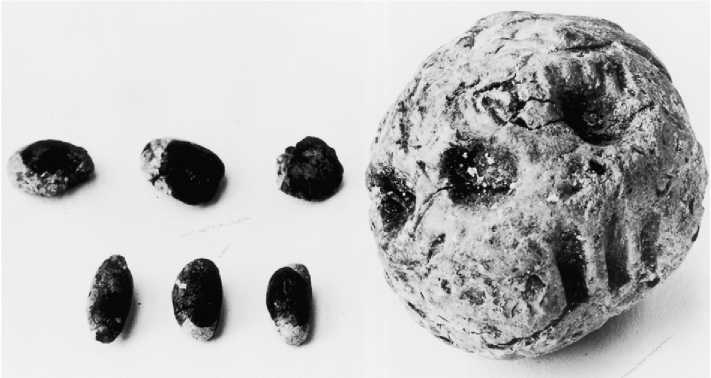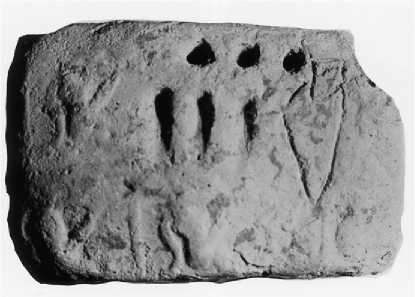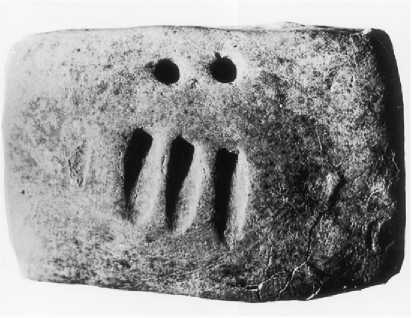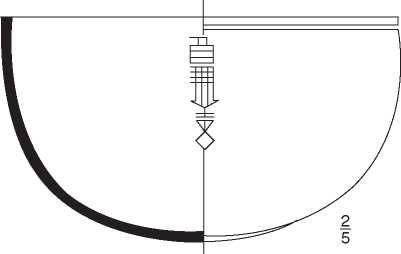During the two centuries following its invention, writing made great strides in Mesopotamia to communicate data more and more efficiently. First, about 3100 BC, the notations in one-to-one-correspondence that suited the archaic method of concrete counting, were superseded by the appearance of abstract numerals - signs that represented abstract numbers used indiscriminately to count various commodities. The impressed signs for measures of grain, the wedge and circular signs became the first numerals standing for 1 and 10. Thirty-three jars of oil were no longer shown by 33 oil-tokens or 33 oil-token impressions. They were indicated by three circular signs and three wedges (Figure 4).
Second, about 3000 BC, personal names were recorded with phonograms - signs standing for

Figure 2 Envelope from Susa, Iran, bearing two lines of signs impressed with the tokens stored inside. Each of the three lenticular disks stand for ten animals (sheep or goats) and each cylinder for one animal amounting to a total of 33 animals.

Figure 4 Tablet from Godin Tepe, Iran, illustrating an incised sign standing for a ‘jar of oil’ preceded by three circular signs each standing for ‘ten’ and three wedges each standing for ‘one’ = 33 jars of oil.

Figure 3 Tablet bearing two lines of impressed signs standing for two large and three small units of grain, from Godin Tepe, Iran.

N
Sounds. These signs are dubbed ‘pictographs’ because they consisted of small sketches of things easy to draw. The signs, however, did not refer to the object they represented, but to the sound of the word they suggested. The drawing of an arrowhead was read ‘ti’ which was the sound of the word for ‘arrowhead’ in Sumerian, the language spoken at the time in the south of Mesopotamia. It is particularly important to note that the stage of ‘pictographs’ never meant writing with small pictures. Instead, the ‘pictographs’ heralded the Mesopotamian phonetic syllabary - the earliest script in which signs represented the sounds of words syllables.
The earliest fully phonetic texts consisted in inscriptions on art objects such as gold vessels and lapis lazuli seals from the Ur Royal cemetery, c. 2700 BC. The short texts merely transcribed the sounds of an individual’s name into signs, for example: Meskalamdug, (Figure 5) or a name and a title, Puabi, Queen. These texts were no longer economic, listing numbers of
Figure 5 Gold bowl, from the royal cemetery of Ur, inscribed with the name of Meskalamdug.
Goods. Instead, their function was funerary. Namely, their purpose was to satisfy the Mesopotamian belief that preserving the name of the dead secured eternal life in the underworld.
At a next stage, worshippers’ statuettes were inscribed with a deceased’s name, title, patronymics, the name of the god or the temple to which the statue was dedicated, and a plea for a long afterlife. This second type of funerary text was a total departure from the logographic lists of goods for bookkeeping. They transcribed the names of individuals, gods, and temples and therefore were almost entirely phonetic. They included verbs and complements, introducing syntax. The texts written on the statuettes started to emulate the sound and structure of spoken language. This represented the take-off of writing. A century later, around 2500 BC, the Mesopotamian cuneiform script was used, for example, to write a lengthy royal text describing the divine birth of a king, his victory against his neighbors, the ensuing treaty and a powerful curse against eventual violators.




 World History
World History









